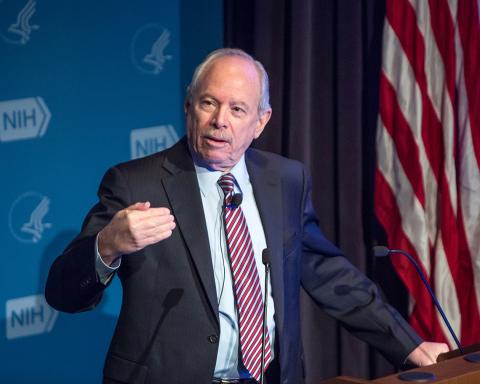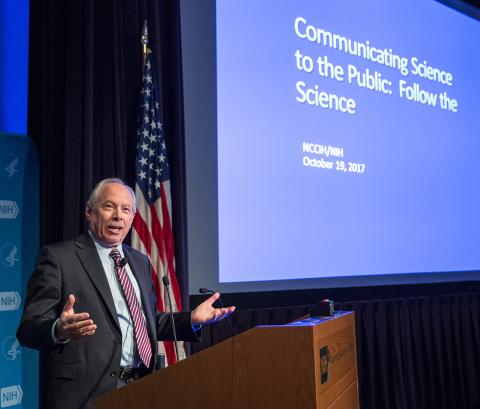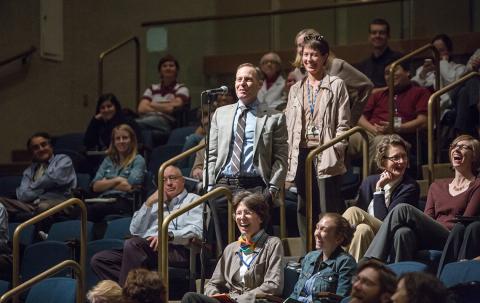Scientists Need Public’s Support to Continue Progress, Leshner Says

Photo: Chia-Chi Charlie Chang
Science has made fantastic progress on virtually every front and, to continue, scientists need the public’s support, argued Dr. Alan Leshner.
“We need the public badly. They are the ultimate receptors for the products of our work,” said Leshner, chief executive officer emeritus at the American Association for the Advancement of Science and former NIDA director, during an Oct. 19 NCCIH lecture in Lipsett Amphitheater on communicating science to the public. “The public only supports science because they think it’s good for society and that it serves society.”
Overall, the public approves of scientific research. Support depends on how productive scientists are, the quality and trustworthiness of “science, the enterprise, not just science, the project,” and what the public learned about science in school.

Photo: Chia-Chi Charlie Chang
Despite progress, Leshner, who has also served as deputy director and acting director of the National Institute of Mental Health and in several roles at the National Science Foundation, has never felt “as uneasy as I do now about the way the public relates to science. They seem ambivalent, indifferent, or, in some cases, hostile to much of science.” Over the past few decades, polls suggest certain demographic segments have lost trust in science.
Certain events, such as scientific misconduct, can damage that trust. He said, for example, that when one scientist is found guilty of conflict of interest, it tarnishes the reputation of thousands of other scientists. Even though these are rare events, the “effect is incredibly pervasive.”
Another reason for mistrust is when scientific findings contradict a group’s core values.
“People don’t make decisions based on science. They bring science into the context of their own goals, knowledge, values and beliefs,” Leshner said. Researchers and the public may have different opinions.
To rebuild trust, he advised scientists to engage with the public at every level by talking with them, not at them.
Engaging the public effectively requires one to think about context—What does the public need to know in order for them to understand the finding? Who is the scientist speaking to and what do they care about? What is the scientist trying to accomplish? Is a scientist, for instance, trying to explain a topic, make an argument or tell a story? These considerations will shape the communication strategy.

Photo: Chia-Chi Charlie Chang
Leshner weaves narratives into his scientific talks. He believes stories are the most effective way to communicate science.
“A lot of what we do feels esoteric and is difficult to bring into a personal context. Often, we can do that by talking about the story of discovery. And then people go, ‘Aha, that’s interesting,’” he said.
Leshner avoids hyperbole, which can “damage the credibility of science.” He’s also learned to speak in soundbites. He once told a reporter that “‘addiction is a brain disease, expressed in behavioral ways and in a social context.” However, the only thing people ever heard was “addiction is a brain disease, because they don’t hear the clauses or caveats.”
Although communicating science is difficult, Leshner said the public must be involved in shaping the research agenda. During his time as NIDA director, he gave talks around the country. At the end of one event, a woman asked him what the difference is between the effect of a drug on a young child’s brain versus an older child’s brain. That question started a research program on the neurological differences between younger and older adolescents.
“NIH has done a great job, I think—better than some other federal agencies—at getting the word out about what it’s discovered. But we need it, and we need a lot more of it,” Leshner concluded. “This stuff that NIH does is fabulous and has tremendous implications and impacts on people.”
